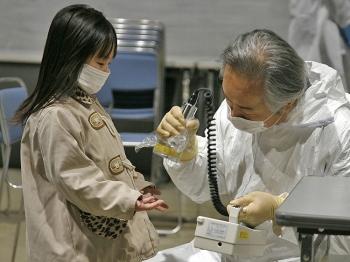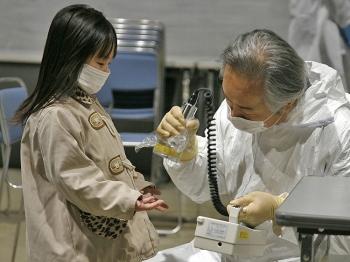Raising the Fukushima nuclear disaster to a level 7, the highest possible rating on the International Nuclear Event Scale, one month after the accident, comes far too late, says nuclear expert David Albright. Albright, a former nuclear inspector, and president and founder of the Institute for Science and International Security (ISIS), says the scale is for alerting the public of the hazard—it is not an official rating to be decided after the fact.
Failure to provide accurate assessment of the severity right after the accident “undermined the purpose of the scale, which is to warn the public what to do,” says Albright.
According to the International Atomic Energy Agency (IAEA) that created the scale,
INES is “a tool for promptly communicating to the public in consistent terms the safety significance” of reported nuclear incidents. The scale goes from 0 to 7. Chernobyl was rated a 7, and Three Mile Island was a 5.
“If they declared it a level 6 right away, other countries would have insisted on helping,” says Albright, who said Japan was too slow to accept help from the United States and other countries with managing the situation at the Fukushima plant.
Originally, Japan’s Nuclear and Industrial Safety Agency assigned INES ratings to individual reactors, rating the explosions at reactors no. 1, 2, and 3 as INES level 5 and reactor no. 4 as level 3. Based on data obtained before March 18, they gave the event an overall rating of level 5.
But Albright says the radioactivity coming out of the different reactors is “a collective hazard to public health.” He says the accident should be assessed comprehensively.
On April 12, the Japanese government announced that “considering information obtained after March 18,” it had recalculated the likely release of radioactive material into the air and the situations of the reactors, and based on that, it was elevating the event to a level 7, the same rating as Chernobyl.
Although the amount of radioactive material released is only 10 percent of what was released at Chernobyl, Fukushima still meets the criteria to be rated a level 7. First, the amount of contamination is significant enough to have a widespread effect on health and the environment. Second, the accident also released a significant amount of radiation within the facility. The third factor of the INES rating is the failure of preventive measures to avert an accident.
The Japanese government now estimates the release of radioactive material at 630,000 terabecquerels, whereas Chernobyl was 5,200,000 terabecquerels. A becquerel measures how radioactive a substance is. One becquerel is equal to the breakdown of one atomic nucleus per second. A terabecquerel is a trillion becquerels.
The earlier assessment of the severity of the accident was based on data obtained before March 18, in the six days following the initial explosion on March 12. But the data available from that period may have been very limited.
In the ISIS report, “Fukushima Crisis: Unmonitored Releases,” Albright and co-authors write that seven of the eight monitoring posts around the perimeter of the Fukushima Daiichi nuclear plant were not operating because of the loss of electricity following the earthquake and tsunami. One may have been operational. At that point, radiation measurements were being collected by mobile monitoring in a car.
Failure to provide accurate assessment of the severity right after the accident “undermined the purpose of the scale, which is to warn the public what to do,” says Albright.
According to the International Atomic Energy Agency (IAEA) that created the scale,
INES is “a tool for promptly communicating to the public in consistent terms the safety significance” of reported nuclear incidents. The scale goes from 0 to 7. Chernobyl was rated a 7, and Three Mile Island was a 5.
“If they declared it a level 6 right away, other countries would have insisted on helping,” says Albright, who said Japan was too slow to accept help from the United States and other countries with managing the situation at the Fukushima plant.
Originally, Japan’s Nuclear and Industrial Safety Agency assigned INES ratings to individual reactors, rating the explosions at reactors no. 1, 2, and 3 as INES level 5 and reactor no. 4 as level 3. Based on data obtained before March 18, they gave the event an overall rating of level 5.
But Albright says the radioactivity coming out of the different reactors is “a collective hazard to public health.” He says the accident should be assessed comprehensively.
On April 12, the Japanese government announced that “considering information obtained after March 18,” it had recalculated the likely release of radioactive material into the air and the situations of the reactors, and based on that, it was elevating the event to a level 7, the same rating as Chernobyl.
Although the amount of radioactive material released is only 10 percent of what was released at Chernobyl, Fukushima still meets the criteria to be rated a level 7. First, the amount of contamination is significant enough to have a widespread effect on health and the environment. Second, the accident also released a significant amount of radiation within the facility. The third factor of the INES rating is the failure of preventive measures to avert an accident.
The Japanese government now estimates the release of radioactive material at 630,000 terabecquerels, whereas Chernobyl was 5,200,000 terabecquerels. A becquerel measures how radioactive a substance is. One becquerel is equal to the breakdown of one atomic nucleus per second. A terabecquerel is a trillion becquerels.
The earlier assessment of the severity of the accident was based on data obtained before March 18, in the six days following the initial explosion on March 12. But the data available from that period may have been very limited.
In the ISIS report, “Fukushima Crisis: Unmonitored Releases,” Albright and co-authors write that seven of the eight monitoring posts around the perimeter of the Fukushima Daiichi nuclear plant were not operating because of the loss of electricity following the earthquake and tsunami. One may have been operational. At that point, radiation measurements were being collected by mobile monitoring in a car.





